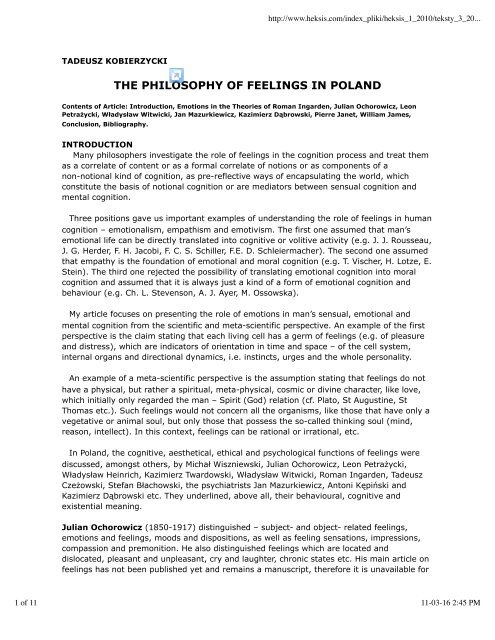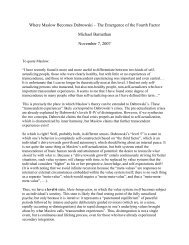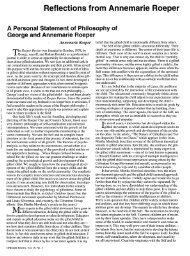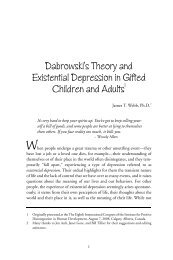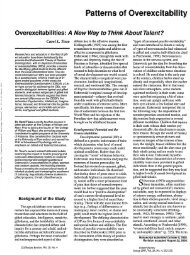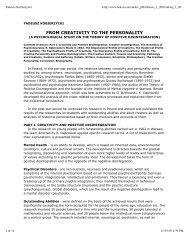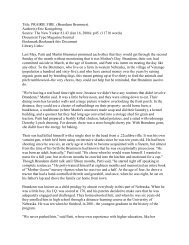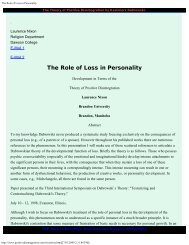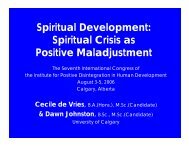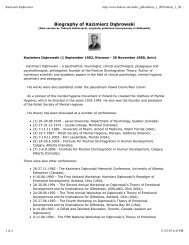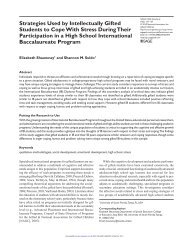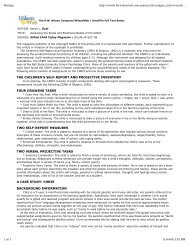the philosophy of feelings in poland - Kazimierz Dabrowski's Theory ...
the philosophy of feelings in poland - Kazimierz Dabrowski's Theory ...
the philosophy of feelings in poland - Kazimierz Dabrowski's Theory ...
You also want an ePaper? Increase the reach of your titles
YUMPU automatically turns print PDFs into web optimized ePapers that Google loves.
http://www.heksis.com/<strong>in</strong>dex_pliki/heksis_1_2010/teksty_3_20...more extensive read<strong>in</strong>g and analysis.This is <strong>the</strong> table <strong>of</strong> contents <strong>of</strong> <strong>the</strong> manuscript titled “The Psychology <strong>of</strong> Feel<strong>in</strong>gs” by JulianOchorowicz (deciphered by Anita Benisławska, Warsaw 2010)”Introductory Part – I. Different Forms <strong>of</strong> Feel<strong>in</strong>g States – 1) Objective and subjectiveimpressions, 2) Emotions and <strong>feel<strong>in</strong>gs</strong>, 3) Moods and dispositions, 4) Feel<strong>in</strong>g sensation,sense <strong>of</strong>, impression, compassion and premonition; II. What dist<strong>in</strong>guishes general subjectivestates from detailed objective states? – 1) The lack <strong>of</strong> clarity <strong>of</strong> affective phenomena, 2) Thequantity oppositions <strong>of</strong> affective phenomena, 3) The Feel<strong>in</strong>g is subjective, 4) A feel<strong>in</strong>g has tohave a location, 5) Feel<strong>in</strong>gs <strong>in</strong> contrast to <strong>in</strong>tellectual states weaken by be<strong>in</strong>g accustomed to<strong>the</strong>m, 6) Feel<strong>in</strong>gs are clearly characterised by <strong>the</strong>ir ma<strong>in</strong> <strong>in</strong>tensity; III. What is <strong>the</strong> differencebetween <strong>in</strong>troverted states <strong>of</strong> pleasure and displeasure; IV. Theories expla<strong>in</strong><strong>in</strong>g <strong>the</strong> justifieddifference between pleas<strong>in</strong>g and displeas<strong>in</strong>g states – 1) Volitional <strong>the</strong>ories, 2) Intellectual<strong>the</strong>ories, 3) Theories <strong>of</strong> actions <strong>in</strong> general, 4) <strong>Theory</strong> <strong>of</strong> growth and loss <strong>of</strong> force, 5) <strong>Theory</strong><strong>of</strong> usefulness, 6) <strong>Theory</strong> <strong>of</strong> nerve and molecular equilibrium, 7) <strong>Theory</strong> <strong>of</strong> contrasts, 8)<strong>Theory</strong> <strong>of</strong> harmony or disharmony between <strong>the</strong> reserves <strong>of</strong> force and <strong>the</strong>ir consumption; V.Criticism <strong>of</strong> <strong>the</strong> hypo<strong>the</strong>sis <strong>of</strong> <strong>the</strong> connection <strong>of</strong> <strong>feel<strong>in</strong>gs</strong> and <strong>the</strong> metabolism; VI. Peripheralchanges dur<strong>in</strong>g feel<strong>in</strong>g states; VII. The evolution <strong>of</strong> feel<strong>in</strong>g expression; VIII. Cry<strong>in</strong>g andLaughter; IX. Chronic states – 1) a Lack, 2) Deduced changes; Part One. Subjectiveimpressions – 1) Subjective external sensations, 2) Auditory sensations, 4) Olfactorysensations, 5) gustatory sensations, 6) tactile sensations; A. Sensations com<strong>in</strong>g frommechanical external stimuli – 1) Prick<strong>in</strong>g, 2) Cutt<strong>in</strong>g, 3) Pierc<strong>in</strong>g, 4) Scratch<strong>in</strong>g, 5) P<strong>in</strong>ch<strong>in</strong>g,6) Hitt<strong>in</strong>g, 7) Gripp<strong>in</strong>g, 8) Sk<strong>in</strong> tear<strong>in</strong>g, 9) Peel<strong>in</strong>g oneself 1), 10) St<strong>in</strong>g<strong>in</strong>g, 11) Itch<strong>in</strong>g, 12)Tickl<strong>in</strong>g, 13) Tighten<strong>in</strong>g; B. Sound sensations at first triggered by external stimuli i.e.physical and chemical – 1) Burn<strong>in</strong>g, 2) Scald<strong>in</strong>g, 3) Freez<strong>in</strong>g, 4) Injure by frostbite, 5)Stra<strong>in</strong><strong>in</strong>g; C. From electric stimuli – 1) Spark st<strong>in</strong>g<strong>in</strong>g; D. From magnetic stimuli; E.Sensations <strong>of</strong> auditory stimuli <strong>in</strong>dependent <strong>of</strong> external stimuli – 1) Neuralgia, 2) Sk<strong>in</strong> pa<strong>in</strong>,3) Itch<strong>in</strong>g, 4) Over-sensitivity; I. Pleasurable tactile sensations – 1) Touch<strong>in</strong>g oneself, 2)Be<strong>in</strong>g touched by someone else, 3) Active touch<strong>in</strong>g <strong>of</strong> someone else, 4) Touch<strong>in</strong>g nonliv<strong>in</strong>gobjects; II. Internal sensory sensations – 1) From <strong>the</strong> muscle organ, 2) From <strong>the</strong> respiratoryorgan, 3) From <strong>the</strong> vocal organ.The presented table <strong>of</strong> contents <strong>of</strong> <strong>the</strong> manuscript <strong>in</strong>dicates a comprehensive approach to<strong>the</strong> issue <strong>of</strong> <strong>feel<strong>in</strong>gs</strong> not only <strong>in</strong> Poland, but <strong>in</strong> Europe <strong>of</strong> Julian Ochorowicz’s times. A lack <strong>of</strong>a broader availability to this text condemns Poles and Europeans to a historical and culturalignorance. It triggers a feel<strong>in</strong>g <strong>of</strong> shame and guilt for <strong>the</strong> negligence <strong>of</strong> scientific <strong>in</strong>stitutions,academies <strong>of</strong> m<strong>in</strong>istries and universities <strong>the</strong> work <strong>of</strong> great Polish scholars – not onlyconcern<strong>in</strong>g <strong>feel<strong>in</strong>gs</strong>. The publication <strong>of</strong> <strong>the</strong> table <strong>of</strong> contents <strong>of</strong> “The Psychology <strong>of</strong> Feel<strong>in</strong>gs”is an attempt to break <strong>the</strong> permanent state <strong>of</strong> ignorance <strong>in</strong> this sphere <strong>of</strong> our nation, even <strong>of</strong>those historians <strong>of</strong> science, who have written wisely on <strong>the</strong> subject <strong>of</strong> Ochorowicz and his<strong>the</strong>ories.Leon Petrażycki (1867-1931) attempted to connect <strong>the</strong> science <strong>of</strong> law and morality wi<strong>the</strong>motional psychology. Firstly, he presented emotions <strong>in</strong> <strong>the</strong> psychology <strong>of</strong> cognition,concentrat<strong>in</strong>g on <strong>the</strong> notion <strong>of</strong> th<strong>in</strong>k<strong>in</strong>g and draw<strong>in</strong>g conclusions. Next, he presentedemotions <strong>in</strong> <strong>the</strong> psychology <strong>of</strong> <strong>feel<strong>in</strong>gs</strong>, discuss<strong>in</strong>g <strong>the</strong> notion <strong>of</strong> affects, passions and moods.He also presented <strong>the</strong> problem <strong>of</strong> emotion <strong>in</strong> <strong>the</strong> psychology and <strong>the</strong>ory <strong>of</strong> <strong>in</strong>st<strong>in</strong>cts. (cf. L.Petrażycki, Russian Ed. 1908, Polish Ed. 1959).Petrażycki ma<strong>in</strong>ta<strong>in</strong>ed that <strong>feel<strong>in</strong>gs</strong> and cognition constitute a basic category <strong>of</strong> psychic2 <strong>of</strong> 11 11-03-16 2:45 PM
http://www.heksis.com/<strong>in</strong>dex_pliki/heksis_1_2010/teksty_3_20...experience. His concern was about experienc<strong>in</strong>g pleasure, satisfaction, delight (“positive<strong>feel<strong>in</strong>gs</strong>”) and experienc<strong>in</strong>g displeasure, discontent, suffer<strong>in</strong>g (“negative <strong>feel<strong>in</strong>gs</strong>”) (cf. L.Petrażycki, 1959, p. 232).He also analysed <strong>the</strong> notion <strong>of</strong> “emotional tone” and “cognitive-emotional complexes” thatconsist <strong>of</strong> cognitive and emotional elements (e.g. as sets <strong>of</strong> imag<strong>in</strong>ations and pleasures,imag<strong>in</strong>ations and displeasures etc.). In his view, those complexes are wrongly called “higher<strong>feel<strong>in</strong>gs</strong>”.Petrażycki referred to notions already function<strong>in</strong>g <strong>in</strong> psychology – affects (Affekte), moods(Stimmungen) and passions (Leidenschaften), as well as to <strong>the</strong>ir <strong>in</strong>tensiveness andextensiveness. He made a critical review and adjusted <strong>the</strong> <strong>the</strong>ories <strong>of</strong> Wilhelm Wundt, ArthurSchopenhauer, William James, Theodor Ribot etc. He carried out an <strong>in</strong>terest<strong>in</strong>g analysis <strong>of</strong><strong>the</strong> relation between emotions, <strong>in</strong>st<strong>in</strong>cts and act <strong>of</strong> man’s will.Jan Mazurkiewicz (1871-1947) <strong>in</strong> his “physiological <strong>the</strong>ory <strong>of</strong> <strong>feel<strong>in</strong>gs</strong>” attempted topresent <strong>the</strong> physiological sources <strong>of</strong> emotions. He referred, among o<strong>the</strong>rs, to <strong>the</strong> discoveries<strong>of</strong> Pierre Janet’s and Sigmund Freud’s <strong>the</strong>ories <strong>of</strong> <strong>feel<strong>in</strong>gs</strong>. He made a critical review <strong>of</strong> <strong>the</strong>psychophysiological assumptions <strong>of</strong> <strong>the</strong> James-Lang concept <strong>of</strong> <strong>feel<strong>in</strong>gs</strong>. He assumed thathuman evolution depends on three ma<strong>in</strong> “regulations”, “programmes”, i.e. engrams. Today,we would say “drivers”, which control <strong>the</strong> cognitive, emotional and behavioural processes <strong>of</strong>an organism.Initially, <strong>the</strong> gnostic, emotional and movement engrams act without diversification. Theirma<strong>in</strong> aim is to realise <strong>the</strong> <strong>in</strong>dividual life programme <strong>of</strong> an organism. Only dur<strong>in</strong>gdevelopment is <strong>the</strong>re a division <strong>of</strong> functions, <strong>the</strong>ir specialization and ga<strong>in</strong><strong>in</strong>g autonomy (cf. J.Mazurkiewicz, „Zarys fizjologicznej teorii uczuć”, vol.1.-1928, vol.2.-1930).“The biological role <strong>of</strong> feel<strong>in</strong>g tendency consists <strong>of</strong> a proper disposition <strong>of</strong> <strong>the</strong> body towardsan impression (irritation) by <strong>the</strong> appropriate activation <strong>of</strong> <strong>the</strong> performance apparatus, andthus appears <strong>the</strong> biological necessity <strong>of</strong> emotional irradiation not <strong>in</strong> one, but <strong>in</strong> bothdirections” (Mazurkiewicz, vol. 2, p. 35).The foundation <strong>of</strong> <strong>the</strong> evolution <strong>of</strong> man’s mental life are <strong>in</strong>st<strong>in</strong>cts, also called drives (vital,sexual, gregarious i.e. syntonic, cognitive). Inst<strong>in</strong>ctive emotionality – is a latent mnemicaffectiveorientation. It becomes active under <strong>the</strong> <strong>in</strong>fluence <strong>of</strong> external stimulus or stronger,energetic discharges <strong>of</strong> cortex centres, under <strong>the</strong> <strong>in</strong>fluence <strong>of</strong> periodical physiological needs.The syntonic drive forms man’s entire emotionality, it set <strong>the</strong> direction for <strong>the</strong> cognitive andmotor drive.Species experiences are established <strong>in</strong> <strong>the</strong> subcortex nodes while <strong>the</strong> <strong>in</strong>dividual ones <strong>in</strong> <strong>the</strong>cortex. The complex <strong>of</strong> species engrams <strong>in</strong>cludes – 1) <strong>the</strong> fundamental ability to recognizeshapes (global), 2) <strong>feel<strong>in</strong>gs</strong> directed at <strong>the</strong> object (klisis) or directed from <strong>the</strong> object(ekklisis), 3) general k<strong>in</strong>aes<strong>the</strong>sia (grasp<strong>in</strong>g or evasive movement). A feel<strong>in</strong>g always has anegative or positive nature <strong>in</strong> various species. The emotional component revives <strong>the</strong> o<strong>the</strong>rcomponents and gives <strong>the</strong>m form and colour.There are orig<strong>in</strong>al and mnemic <strong>feel<strong>in</strong>gs</strong>, i.e. <strong>feel<strong>in</strong>gs</strong> derived from <strong>the</strong> direct impulse <strong>of</strong>sensations or from <strong>the</strong> remember<strong>in</strong>g such an impulse.3 <strong>of</strong> 11 11-03-16 2:45 PM
http://www.heksis.com/<strong>in</strong>dex_pliki/heksis_1_2010/teksty_3_20...The syntonic drive develops itself dur<strong>in</strong>g phylogenesis from <strong>the</strong> sexual and family drive(gregarious, ancestral), and not by <strong>the</strong> sublimation <strong>of</strong> <strong>the</strong> libido <strong>in</strong> <strong>in</strong>dividual life (cf. S.Freud). Syntony is an emotional phenomemon <strong>of</strong> co-sound<strong>in</strong>g (Eugen Bleuler), whichsupports <strong>the</strong> build<strong>in</strong>g <strong>of</strong> social relations. Schizoid behaviour (psychopathy, psychosis) lacksit. Its excess <strong>in</strong> adult life means a development <strong>of</strong> an <strong>in</strong>hibition <strong>of</strong> social <strong>feel<strong>in</strong>gs</strong>.In his concept, J. Mazurkiewicz attributed a huge role to organic <strong>feel<strong>in</strong>gs</strong>: - “<strong>the</strong>psychophysiological significance <strong>of</strong> organic <strong>feel<strong>in</strong>gs</strong> is <strong>in</strong>comparably bigger than <strong>the</strong>psychological one, because <strong>the</strong>y are <strong>the</strong> only source <strong>of</strong> <strong>the</strong> active force <strong>of</strong> <strong>the</strong> dynamics <strong>of</strong><strong>the</strong> whole emotional life” (J. Mazurkiewicz, vol. 2, p. 47). This group <strong>in</strong>cludes e.g. an <strong>in</strong>nateimpression <strong>of</strong> a filled bladder. The complex <strong>of</strong> <strong>the</strong>se emotional sensations and <strong>the</strong> system <strong>of</strong>reaction to such sensations rema<strong>in</strong>s <strong>in</strong> its primeval form till <strong>the</strong> end <strong>of</strong> man’s life.The organic feel<strong>in</strong>g which f<strong>in</strong>d its reference po<strong>in</strong>t <strong>in</strong> <strong>the</strong> cortex, stops its previoussensations (pol. odczucia zmysłowe), which creates a conflict between <strong>the</strong> organic <strong>feel<strong>in</strong>gs</strong>.Victorious is <strong>the</strong> one, which is more strongly bounded with <strong>the</strong> movement system, whichallows a discharge <strong>of</strong> present stress. The dysfunctions <strong>of</strong> organic <strong>feel<strong>in</strong>gs</strong> are responsible foremotional pathologies.Accord<strong>in</strong>g to Jan Mazurkiewicz – “each organic sensation, <strong>of</strong> a sufficient <strong>in</strong>tensity, has all<strong>the</strong> traits or dimensions <strong>of</strong> a feel<strong>in</strong>g” (J. Mazurkiewicz, vol. 2, p. 41). In <strong>the</strong> activity <strong>of</strong> <strong>the</strong>organic <strong>feel<strong>in</strong>gs</strong>, as well as <strong>in</strong> that <strong>of</strong> o<strong>the</strong>rs, an important role is played by <strong>the</strong> <strong>feel<strong>in</strong>gs</strong> <strong>of</strong>displeasure and pleasure.The oldest organic sensation is pa<strong>in</strong>. Not only does it deorganize <strong>the</strong> system <strong>of</strong> emotionaland cognitive reactions, but it also breaks us out from <strong>the</strong> normal perception <strong>of</strong> time. Severepa<strong>in</strong> may hamper logical processes and lead to unconsciousness. (cf. J. Mazurkiewicz, vol. 2,p. 43). In <strong>the</strong> thirties a several dozen <strong>of</strong> k<strong>in</strong>ds <strong>of</strong> pa<strong>in</strong> were identified (e.g. Baunis – 83,Hahnemann – 73).Inst<strong>in</strong>ctive <strong>feel<strong>in</strong>gs</strong> have a hereditary nature and are transferred as schemas <strong>of</strong> emotionalreactions remembered by generations. They exist as stable, latent mnemic-affectiveorientations, which are dynamized under <strong>the</strong> <strong>in</strong>fluence <strong>of</strong> specific situations and externalstimuli.Thanks to <strong>in</strong>st<strong>in</strong>ctive <strong>feel<strong>in</strong>gs</strong>, a child wakes up from time to time <strong>in</strong> order to reproduce andreactivate his time-spatial, bodily and emotional contact with its mo<strong>the</strong>r. It does so by sat<strong>in</strong>gits physical, bodily and emotional hunger, <strong>in</strong> order to support <strong>the</strong> evolution <strong>of</strong> <strong>the</strong> higherstructures <strong>of</strong> its own nervous system. The state <strong>of</strong> sleep is an extension <strong>of</strong> <strong>the</strong> foetal state.The state <strong>of</strong> vigil is aroused by <strong>in</strong>st<strong>in</strong>ctive mechanisms.Jan Mazurkiewicz also dist<strong>in</strong>guishes prelogical <strong>feel<strong>in</strong>gs</strong> that are isolated, magical andpresent <strong>in</strong> a child until it is seven years old (and <strong>in</strong> <strong>in</strong>digenous peoples). Dur<strong>in</strong>g adulthood<strong>the</strong>y can be caused by <strong>the</strong> damage <strong>of</strong> <strong>the</strong> coord<strong>in</strong>ative-hierarchical structure <strong>of</strong> <strong>the</strong> frontallobe. Such damage destroys <strong>the</strong> control <strong>of</strong> prelogical emotions. Prelogical emotions arestimulated and appear <strong>in</strong> <strong>the</strong> production <strong>of</strong> visual symbols <strong>in</strong> <strong>the</strong> reality, similarly as <strong>in</strong> adream. There is a lack <strong>of</strong> critical, logical control <strong>of</strong> those symbols.Symptoms <strong>of</strong> prelogical emotions appear <strong>in</strong> <strong>in</strong>dividual and group psychoses (national4 <strong>of</strong> 11 11-03-16 2:45 PM
http://www.heksis.com/<strong>in</strong>dex_pliki/heksis_1_2010/teksty_3_20...megalomania, fanaticism, nationalism, ideological e.g. fascism, communism, delusionaltendencies, crimes etc.). Their positive mean<strong>in</strong>g is observed <strong>in</strong> scientific and artistic works,when <strong>the</strong>y are <strong>in</strong>cluded <strong>in</strong> <strong>the</strong> hierarchical activity <strong>of</strong> logical functions.Orig<strong>in</strong>al and irradiated <strong>feel<strong>in</strong>gs</strong> exist that have a free and conditioned nature.Organic sensations differ from sensory sensations (orig<strong>in</strong>al and memory based), which arecomb<strong>in</strong>ed with a gnostic component. “All sensory sensations (visual, auditory, tactile) are bynature <strong>in</strong>different, as opposed to orig<strong>in</strong>al sensations and can receive an emotional evaluation(colour) by <strong>the</strong> latter directly or <strong>in</strong>directly (J. Mazurkiewicz, vol. 2, p. 45).The emotionally active subcortex charges transmit energy to <strong>the</strong> cortex, which producedby emotional irritations, attribut<strong>in</strong>g a positive (pleasurable) or negative (upsett<strong>in</strong>g) tone.Conditional <strong>feel<strong>in</strong>gs</strong> are created at <strong>the</strong> cortex level, evoked by a phenomenon <strong>of</strong> <strong>the</strong>irradiation <strong>of</strong> <strong>the</strong> organic feel<strong>in</strong>g’s stress, which is <strong>in</strong>cluded to <strong>the</strong> gnostic trait <strong>of</strong> o<strong>the</strong>rcomplex.Thanks to emotional irradiation, it is possible to cross <strong>the</strong> level <strong>of</strong> organic and impulsiveemotionality. The first emotional conditional reflex <strong>of</strong> <strong>the</strong> child is joy or sorrow at <strong>the</strong> sight <strong>of</strong>its mo<strong>the</strong>r. Conditional <strong>feel<strong>in</strong>gs</strong> rema<strong>in</strong> <strong>in</strong> relation with any k<strong>in</strong>d <strong>of</strong> practical activity, artisticwork, science, upbr<strong>in</strong>g<strong>in</strong>g and social behaviour, as well mental development.Higher <strong>feel<strong>in</strong>gs</strong> also exist, which are <strong>the</strong> <strong>in</strong>hibitors <strong>of</strong> <strong>the</strong> <strong>in</strong>st<strong>in</strong>cts, and if <strong>the</strong>re are no such<strong>feel<strong>in</strong>gs</strong>, <strong>the</strong>re are no restra<strong>in</strong>ts as well, even if <strong>the</strong> <strong>in</strong>st<strong>in</strong>ct is correct. Their role consists <strong>of</strong><strong>in</strong>hibit<strong>in</strong>g <strong>the</strong> activity <strong>of</strong> <strong>in</strong>st<strong>in</strong>cts and correct<strong>in</strong>g <strong>the</strong>ir emotional expression. Thanks to this, itis possible to create a world <strong>of</strong> autonomic, non-impulsive emotions, which <strong>in</strong>dividualizeman’s cognition and activities <strong>in</strong> <strong>the</strong> world.Wladyslaw Witwicki (1878-1948) by referr<strong>in</strong>g amongst o<strong>the</strong>rs to Wundt’s <strong>the</strong>ory,dist<strong>in</strong>guished: 1) simple <strong>feel<strong>in</strong>gs</strong> (pleasure and displeasure), 2) emotional processes, 3)higher <strong>feel<strong>in</strong>gs</strong>, 4) moods (a temporary disposition to a certa<strong>in</strong> type <strong>of</strong> feel<strong>in</strong>g) and 5) affects– as sudden <strong>feel<strong>in</strong>gs</strong> – s<strong>the</strong>nic and non-s<strong>the</strong>nic, <strong>in</strong>st<strong>in</strong>ctive and habitual. He named all <strong>the</strong>re– 6) emotional life (cf. W. Witwicki, Psychologia, vol. 2, 1963, p. 17).Witwicki dist<strong>in</strong>guished – <strong>in</strong>st<strong>in</strong>cts, <strong>feel<strong>in</strong>gs</strong> and affects. He described ways <strong>of</strong> “subject<strong>in</strong>g<strong>feel<strong>in</strong>gs</strong>” – by suggestion, imitation or by perform<strong>in</strong>g <strong>the</strong> symptoms. He also accepted <strong>the</strong>possibility <strong>of</strong> <strong>the</strong> irradiation <strong>of</strong> <strong>feel<strong>in</strong>gs</strong>, <strong>the</strong>ir <strong>in</strong>fluence on <strong>in</strong>different objects. He found that<strong>the</strong>y <strong>in</strong>fluence judgements and actions, as well as evoke th<strong>in</strong>k<strong>in</strong>g.Roman Ingarden (1893-1970), while referr<strong>in</strong>g to Robert Vischer’s <strong>the</strong>ory, spokeapprov<strong>in</strong>gly about <strong>the</strong> directness <strong>of</strong> empathy, which embraces “coexistence” (miterleben)and “co-feel<strong>in</strong>g” (an, nach, zu – fuhlen). It consists <strong>of</strong> <strong>in</strong>sert<strong>in</strong>g or plac<strong>in</strong>g someth<strong>in</strong>g on <strong>the</strong>object, which happens at <strong>the</strong> moment and spontaneously. Yet, he rejected his <strong>the</strong>ory <strong>of</strong>“mental <strong>in</strong>fect<strong>in</strong>g’, react<strong>in</strong>g with joy to joy, or with sadness to sadness by means <strong>of</strong> anemotional imitation <strong>of</strong> <strong>the</strong> o<strong>the</strong>r person. This concept was easily accepted <strong>in</strong> psychiatry, butwas questioned by <strong>philosophy</strong>.Roman Ingarden thought that what appears here is a k<strong>in</strong>d <strong>of</strong> “sens<strong>in</strong>g” (Erfuhlen) andreact<strong>in</strong>g <strong>of</strong> <strong>the</strong> similar to <strong>the</strong> similar. Empathy is a direct experience, it shows and makesforeign mental states available, when what is empathized becomes “present” (not justthought or imag<strong>in</strong>ed). R. Ingarden stated that “empathiz<strong>in</strong>g is <strong>the</strong> direct exploratory5 <strong>of</strong> 11 11-03-16 2:45 PM
http://www.heksis.com/<strong>in</strong>dex_pliki/heksis_1_2010/teksty_3_20...experience, <strong>the</strong> one that gives us knowledge, this direct identification with <strong>the</strong> o<strong>the</strong>r person,walk<strong>in</strong>g <strong>in</strong> his shoes; <strong>in</strong>direct and consequent empathiz<strong>in</strong>g appears when it is still needed.”(Ingarden 1981, p.72)Cognition through empathy is needed, because notional knowledge does not create a directaccess to <strong>the</strong> object. This stance can be accepted not by phenomenologists, but also bypsychoanalysts and existentialists.A certa<strong>in</strong> k<strong>in</strong>d <strong>of</strong> cognition is based on “observation filled with emotions” or “observation<strong>in</strong>fused spiritually with emotions” <strong>of</strong> objects (cf. R. Ingarden, 1981, p. 79). When <strong>the</strong> m<strong>in</strong>d isable to <strong>in</strong>tegrate its own cognitive processes with objects that he perceives, <strong>the</strong>n onlyemotional experiences are comb<strong>in</strong>ed and various cognitive elements are arranged <strong>in</strong> acognitive hierarchy.Most phenomenologists gave a feel<strong>in</strong>g a soul (<strong>in</strong> case <strong>of</strong> <strong>in</strong>dividual experiences) or a spirit(<strong>in</strong> case <strong>of</strong> collective experiences). Roman Ingarden thought that “sensory sensation”(Empf<strong>in</strong>den) can embrace all emotions (Pol. “wzruszenia”).<strong>Kazimierz</strong> Dąbrowski (1902-1980) was <strong>the</strong> only Polish author to connect <strong>the</strong> notions <strong>of</strong>syntony, sympathy and empathy <strong>in</strong> his own concept <strong>of</strong> <strong>the</strong> personality’s evolution anddevelopment. It beg<strong>in</strong>s from <strong>the</strong> activization <strong>of</strong> <strong>the</strong> genetic, impulsive and emotionalstructure with<strong>in</strong> <strong>the</strong> environment and self-activity (I). Emotions are connected with primevalreflexes <strong>of</strong> <strong>the</strong> nervous system, formed as <strong>the</strong> defence <strong>in</strong>st<strong>in</strong>ct. It coexists with <strong>the</strong> fight<strong>in</strong>st<strong>in</strong>ct (temperament syntony). In his <strong>the</strong>ory, K. Dąbrowski referred to, among o<strong>the</strong>rs, <strong>the</strong><strong>the</strong>ory <strong>of</strong> P. Janet and W. James.Pierre Janet assumed that a feel<strong>in</strong>g is a k<strong>in</strong>d <strong>of</strong> <strong>in</strong>ner act<strong>in</strong>g, not a passive experience. Hestarted from analys<strong>in</strong>g <strong>the</strong> feel<strong>in</strong>g <strong>of</strong> empt<strong>in</strong>ess, i.e. <strong>the</strong> analysis <strong>of</strong> reactions evoked by <strong>the</strong>lack <strong>of</strong> <strong>feel<strong>in</strong>gs</strong>, pronounc<strong>in</strong>g lack <strong>of</strong> <strong>the</strong> so-called derivative activities. Those activities are –<strong>the</strong> feel<strong>in</strong>g <strong>of</strong> exhaustion and effort. One supports <strong>the</strong> primeval activity, ano<strong>the</strong>r onesuspends it. In sadness, <strong>the</strong>re is a reaction <strong>of</strong> failure, <strong>in</strong> joy a reaction <strong>of</strong> triumph. The basic<strong>feel<strong>in</strong>gs</strong> are <strong>the</strong> feel<strong>in</strong>g <strong>of</strong> stress and effort, idleness and discouragement, exhaustion,melancholy and sadness, rapture and joy (cf. Janet 1926 & 1928).William James ma<strong>in</strong>ta<strong>in</strong>ed that “emotion dissociated from all bodily feel<strong>in</strong>g is<strong>in</strong>conceivable.” (James 1890). Accord<strong>in</strong>g to him <strong>the</strong>re is a countless number <strong>of</strong> types <strong>of</strong>emotions and <strong>the</strong>ir varieties, e.g. “what may be called <strong>the</strong> »coarser« emotions, grief, fear,rage, love, <strong>in</strong> which every one recognizes a strong organic reverberation, and afterwardsspeak <strong>of</strong> <strong>the</strong> »emotions«, or <strong>of</strong> those whose organic reverberation is less obvious andstrong” – moral, <strong>in</strong>tellectual, aes<strong>the</strong>tic and bodily reactions connected with <strong>the</strong>m. Accord<strong>in</strong>gto James “one mental state is not immediately <strong>in</strong>duced by <strong>the</strong> o<strong>the</strong>r, that <strong>the</strong> bodilymanifestations must first be <strong>in</strong>terposed between (…).” (James 1890)Accord<strong>in</strong>g to K. Dąbrowski, primeval emotionality is <strong>in</strong>tegrated with <strong>the</strong> <strong>in</strong>st<strong>in</strong>cts, it ischaracterised by biological defence reactions connected with susta<strong>in</strong><strong>in</strong>g physical or mentallife. Next <strong>the</strong>re are dynamics <strong>of</strong> primeval affective sympathy and antipathy, which are anexpression <strong>of</strong> changeable reactions, sensations and moods connected with social relations.Ambivalence and ambitendence dom<strong>in</strong>ate here. They are emotional <strong>in</strong>sights, which aresubject to permanent divisions, dispers<strong>in</strong>g or concentration for <strong>the</strong> purpose <strong>of</strong> defend<strong>in</strong>g ego.6 <strong>of</strong> 11 11-03-16 2:45 PM
http://www.heksis.com/<strong>in</strong>dex_pliki/heksis_1_2010/teksty_3_20...Feel<strong>in</strong>gs at this level are <strong>of</strong>ten contradicted and present <strong>the</strong>mselves as moods, imposed by<strong>the</strong>ir own body sensations or environment pressure. Emotional cognition <strong>of</strong> this type has anidentification and projective character – directed at <strong>the</strong> outside where it is balanced throughemotional cognition <strong>of</strong> <strong>in</strong>trojective character.Projective emotional <strong>in</strong>sight transforms itself <strong>in</strong>to <strong>in</strong>trojective <strong>in</strong>sight and <strong>the</strong>n <strong>in</strong>to a“connective” <strong>in</strong>sight, creat<strong>in</strong>g a type <strong>of</strong> emotional cognitive organ – an emotional subject, anemotional soul or emotional “self”, <strong>in</strong>dividual or group.Impulsive-emotional or social-emotional formations can atta<strong>in</strong> some sort <strong>of</strong> emotionalconscience, which identifies negative and positive emotions, analyses <strong>the</strong>m <strong>in</strong>tellectually anddebilitates <strong>the</strong>ir negative <strong>in</strong>fluence.At this level, <strong>the</strong> Ego takes <strong>the</strong> energy <strong>of</strong> <strong>the</strong> negative and isolated emotions <strong>in</strong> order tocreate emotional formations <strong>of</strong> a higher level, which are, among o<strong>the</strong>rs, love for o<strong>the</strong>rs andoneself and friendship. Energy is taken from <strong>the</strong> cognitive and emotional acts, which are:wonder about oneself, dissatisfaction with oneself and <strong>the</strong> feel<strong>in</strong>g <strong>of</strong> shame and guilt.The critical moment is <strong>the</strong> chang<strong>in</strong>g <strong>of</strong> <strong>the</strong> energy <strong>of</strong> those emotions <strong>in</strong>to a new structure<strong>of</strong> mental organisation, which is called by K. Dąbrowski “positive maladjustment”, which<strong>in</strong>cludes an <strong>in</strong>tellectual, emotional and behavioural component. Its opposition are <strong>the</strong><strong>in</strong>tellectual and emotional acts <strong>of</strong> self-choice, self-affirmation and self-upbr<strong>in</strong>g<strong>in</strong>g, thus atype <strong>of</strong> global self-cognition.Perceiv<strong>in</strong>g <strong>the</strong> world and oneself by means <strong>of</strong> feel<strong>in</strong>g can be – automatic, spontaneous and<strong>in</strong>tentional. In <strong>the</strong> first case, it is <strong>in</strong>st<strong>in</strong>ctive and sensory perception, <strong>in</strong> <strong>the</strong> second one –impressionistic and emotional perception, and <strong>in</strong> <strong>the</strong> third one – imag<strong>in</strong>ary and mental. All<strong>the</strong>se perceptions are subject to passive or active transcendence.Primeval emotional syntony, which has an impulsive character, is differentiated only under<strong>the</strong> <strong>in</strong>fluence <strong>of</strong> emotional antipathy and sympathy. The evolution <strong>of</strong> emotional <strong>in</strong>sights goesfrom atmospheric “syntony”, through affective “sympathy”, to emotional “empathy”. Apartfrom those three emotional factors act<strong>in</strong>g on <strong>the</strong> basis <strong>of</strong> <strong>the</strong> evolutionary model, <strong>the</strong>re aremany factors that <strong>in</strong>tegrate <strong>the</strong>m or dis<strong>in</strong>tegrate <strong>the</strong>m.CONCLUSIONBefore <strong>the</strong> Second World War, <strong>the</strong>ories <strong>of</strong> William James, William McDougall, HenriBergson, Wilhelm Wundt, Theodor Ribot, Piotr Bovet and Pierre Janet were popular <strong>in</strong>Poland. They are based on <strong>the</strong> conviction that <strong>the</strong>re is a strong relation between emotionsand <strong>the</strong> body, and that bodily sensations play a role <strong>in</strong> <strong>the</strong> modification <strong>of</strong> man’s emotionalstructures. Here are two examples:Pierre Janet states that James’ description lacks <strong>the</strong> psychic element. Yet, he himselfwanted to describe <strong>the</strong>m only from <strong>the</strong> outside. Janet and James are sensitive as for <strong>the</strong>disorder that each emotion presents, so <strong>the</strong>y describe this emotion as a k<strong>in</strong>d <strong>of</strong> less adaptedbehaviour or a maladaptive behaviour or even – behaviour <strong>of</strong> failure (cf. Sartre 2002).“Thus <strong>the</strong> physiological <strong>the</strong>ory <strong>of</strong> James has led us, by its own <strong>in</strong>sufficiency, to Janet’s<strong>the</strong>ory <strong>of</strong> behaviour, and <strong>the</strong> latter to <strong>the</strong> <strong>the</strong>ory <strong>of</strong> functional emotion <strong>in</strong> form-psychology,and this refers us f<strong>in</strong>ally to consciousness” (Sartre 2002, p. 28). Sartre <strong>in</strong>cludes to importantdiscoveries <strong>in</strong> <strong>the</strong> process <strong>of</strong> recogniz<strong>in</strong>g <strong>the</strong> role <strong>of</strong> emotions, <strong>the</strong> <strong>the</strong>ory <strong>of</strong> emotion-<strong>in</strong>st<strong>in</strong>ct,7 <strong>of</strong> 11 11-03-16 2:45 PM
http://www.heksis.com/<strong>in</strong>dex_pliki/heksis_1_2010/teksty_3_20...<strong>the</strong> <strong>the</strong>ory <strong>of</strong> emotion-purpose (psychoanalysis) and <strong>the</strong>ory <strong>of</strong> emotion-consciousness(phenomenology).The contemporary reflection <strong>of</strong> Polish philosophers on <strong>the</strong> issue <strong>of</strong> <strong>the</strong> role <strong>of</strong> <strong>feel<strong>in</strong>gs</strong> <strong>in</strong>cognition and emotion <strong>in</strong> action is quite limited. Older philosophers attempted not toseparate emotional acts from sensory, <strong>in</strong>tellectual and performative act analysis. Bodilyimpulses (pressure, impression, <strong>in</strong>st<strong>in</strong>ct, drive, movement) and <strong>in</strong>tellectual impulses(thought, attention, observation, meditation) act and evoke emotions. These are not onlysensory, but also m<strong>in</strong>d reactions which form multidimensional and multileveled cognitivephenomena.At a Philosophical Convention <strong>in</strong> Piotraw<strong>in</strong>, <strong>in</strong> <strong>the</strong> spr<strong>in</strong>g <strong>of</strong> 2010, a philosopher from Lubl<strong>in</strong>,Stefan Symotiuk, presented a long list <strong>of</strong> questions concern<strong>in</strong>g <strong>the</strong> cognitive role <strong>of</strong> <strong>feel<strong>in</strong>gs</strong>– 1) What are “experiences”? 2) What are “moods” – “emotions” – “passions”? 3) Is emotiona condensed, <strong>in</strong>tensive atmosphere (fear, terror), is <strong>the</strong> atmosphere objectless (fear) andemotions objective (fear <strong>of</strong> <strong>the</strong> dog)? 4) Do “mixed states” concern moods <strong>in</strong>dividually(gloom<strong>in</strong>ess, long<strong>in</strong>g); or moods + emotions (gloom + fear = fury)? 5) Do emotionalexperiences differ as far temporal direction is concerned (towards <strong>the</strong> past, present, future)?6) Do different <strong>feel<strong>in</strong>gs</strong> “recognize” by head<strong>in</strong>g towards objects – people – abstractions (lovefor nature – children – beauty)? 7) Do <strong>feel<strong>in</strong>gs</strong> “recognize” (can we recognize <strong>the</strong> world byregret)? 8) Is <strong>the</strong>re knowledge that impairs <strong>feel<strong>in</strong>gs</strong> and one that enhances it? 9) What is <strong>the</strong>relation between experiences and “needs” (for security, food, community, value, creation)?10) Are relations among emotions hierarchical or “central-peripheral”? 11) Are <strong>the</strong>recontradictory experiences (ei<strong>the</strong>r – or), or is it possible for <strong>the</strong>m to “mix” toge<strong>the</strong>r? Does“pure love”, “pure fear”, “pure hope” exist? 12) What is <strong>the</strong> difference between: <strong>the</strong> feel<strong>in</strong>g<strong>of</strong> passion, <strong>the</strong> passion for someth<strong>in</strong>g, and hope? 13) How do organised emotions (organisedregret – grief, aggressiveness – war enthusiasm) exist? 14) What is <strong>the</strong> relation betweenemotions and: melancholic, sangu<strong>in</strong>ic, choleric temperament? 15) What causes <strong>the</strong>expiration <strong>of</strong> <strong>feel<strong>in</strong>gs</strong> and what causes <strong>the</strong> non-expiration <strong>of</strong> <strong>feel<strong>in</strong>gs</strong> (eternal love)? 16)What is “emotional frigidity”? 17) Is it possible to “feel” o<strong>the</strong>r emotional states, or just “putoneself <strong>in</strong>to <strong>the</strong>ir position”?It seems as though all that is great <strong>in</strong> man goes beyond <strong>the</strong> borders <strong>of</strong> pleasure anddispleasure, lik<strong>in</strong>g and dislik<strong>in</strong>g. In an act <strong>of</strong> emotional <strong>in</strong>sight, man can go beyond his ownexistence <strong>in</strong> order to understand and to get know himself better. Senses, <strong>feel<strong>in</strong>gs</strong> and <strong>the</strong>m<strong>in</strong>d are <strong>the</strong> sacred triad <strong>of</strong> human cognition and should be exam<strong>in</strong>ed for <strong>the</strong> good <strong>of</strong>mank<strong>in</strong>d.BIBLIOGRAPHYAristotle (1941), „Rhetoric”, trans. R. McKeon, <strong>in</strong>: The Works <strong>of</strong> Aristotle, New YorkAristotle (1996), The A<strong>the</strong>nian Constitution, The Eudemian Ethics, On Virtues and Vices, withan English translation by H. Rackham, Cambridge Massachusetts, LondonAristotle (1984) “On <strong>the</strong> Soul”, trans. J. A. Smith, <strong>in</strong>: “The Complete Works <strong>of</strong> Aristotle”, Vol.1, Edited by J. Barnes, Pr<strong>in</strong>cetonBedford, E. (1956-7), „Emotion”, Proceed<strong>in</strong>gs <strong>of</strong> <strong>the</strong> Aristotelian Society 57 (1956-7):281-304.Brentano F. (1971), „Psychology from <strong>the</strong> Empirical Standpo<strong>in</strong>t”, trans. D.B. Terrell, LondonBrentano F. (1989), „O źródle poznania moralnego”, przełożył, wstępem i przypisami opatrzyłCz. Porębski, przekład przejrzał A. Węgrzecki, WarszawaBrentano F.(1999), „Psychologia z empirycznego punktu widzenia”, przełożył, wstępem i8 <strong>of</strong> 11 11-03-16 2:45 PM
http://www.heksis.com/<strong>in</strong>dex_pliki/heksis_1_2010/teksty_3_20...przypisami opatrzył W. Galewicz, WarszawaBuczyńska-Garewicz H.(1975), „Uczucia i rozum w świecie wartości. Z historii filoz<strong>of</strong>iiwartości”, WrocławCalhoun C. and Solomon, R. (eds) (1984), „ What is an Emotion? New YorkCannon W. (1929), „Bodily Changes <strong>in</strong> Pa<strong>in</strong>, Hunger, Fear and Rage”, New YorkChurchland P. S. (1990), „Neuro<strong>philosophy</strong>”, Cambridge, MACzeżowski T. (1989), „Strach i lęk. Przyczynek do klasyfikacji uczuć” w: Pisma z etyki i teoriiwartości, WrocławCyrulnik B. (1997), „Anatomia uczuć”, tłum. B.A. Matusiak, WarszawaDąbrowski K. (1984), „Funkcje i struktura emocjonalna osobowości”, Lubl<strong>in</strong>Dąbrowski K. (1996), „Multilevelness <strong>of</strong> emotional and <strong>in</strong>st<strong>in</strong>ctive functions”, Lubl<strong>in</strong>Dąbrowski K. (1971), „Syntonia i empatia” w: K. Dąbrowski, „Pojęcia żyją i rozwijają się”, ss.94-96, LondonDąbrowski K. (1989), „Elementy filoz<strong>of</strong>ii rozwoju”, WarszawaDescartes R. (2001), „Namiętności duszy”, tłum. L. Chmaj, KętyDescartes R. (1995), „Listy do księżniczki Elżbiety”, tłum. J. Kopania, WarszawaDescartes R. (1989), “Passions <strong>of</strong> <strong>the</strong> Soul”, trans. S. Voss, IndianapolisDe Sousa R. (1987), „ The Rationality <strong>of</strong> Emotion”, Cambridge, MAEliasz H. (1980), „O sposobach rozumienia pojęcia »empatia«”, „Przegląd Psychologiczny” nr3, ss. 469-482.Ekman P., Davidson R.J. (red.) (1998), „Natura emocji. Podstawowe zagadnienia”, tłum. B.Wojciszke, GdańskFreeman K. (1948), “Ancilla to <strong>the</strong> Pre-Socratic Philosophers”, CambridgeGerstmann S. (1986), „Rozwój uczuć”, WarszawaGibbard A. (1990), Wise Choices, Apt Feel<strong>in</strong>gs: A <strong>Theory</strong> <strong>of</strong> Normative Judgment,Cambridge, MAGoleman D. (1997), „Inteligencja emocjonalna”, tłum. A. Jankowski, PoznańGreenspan P. (1988), „Emotions and Reasons”, New YorkGrzeliński A.(2005) „Kategorie podmiotu i przedmiotu w Dawida Hume’a nauce o naturzeludzkiej”, ToruńGrzywak-Kaczyńska M. (1971), „Rola empatii w psychoterapii i wychowaniu”, „ZagadnieniaWychowawcze w Aspekcie Zdrowia Psychicznego” nr 1-2.Hartmann N. (1931), Zum Problem der Realitatsgegebenheit, Berl<strong>in</strong>Hegel G. W. F. (1977), „Phenomenology <strong>of</strong> Spirit”, trans A.V. Miller, OxfordHegel G. W. F. (1963/2010), „Fenomenologia ducha”, t. 1, tłum. Adam Landmann, WarszawaHe<strong>in</strong>rich W. (1907), „Psychologia uczuć”, KrakówHetman G. (1995), „Uczucia i wartości według Jana Mazurkiewicza”, Lubl<strong>in</strong>Hume, D. (2007), „A Treatise <strong>of</strong> Human Nature”, ed. D.F. & M. J Norton, OxfordHume D. (1963), „Traktat o naturze ludzkiej”, przeł. Czesław Znamierowski, WarszawaHume D. (1969), „A Treatise on Human Nature”, Ed. E. C. Mossner, London (wg. A.Grzeliński, Toruń 2005)Hume D. (1882), „A Dissertation on <strong>the</strong> Passions”, w: „The Philosophical Works”, Ed. Th.Green, T. H. Grose, London (wg. A. Grzeliński, Toruń 2005)Husserl E. (1967), „Idee czystej fenomenologii i fenomenologicznej filoz<strong>of</strong>ii”, tłum. D.Gierulanka, WarszawaHusserl E. (1988), „W sprawie <strong>in</strong>tencjonalności uczuć”, tłum. W. Galewicz w: Z fenomenologiiwartości, s.30-38. KrakówHusserl E. (1928), „Logische Untersuschungen“, ed. IV, Halle/Salle 1928, t. II, cz. 1.Hutcheson, F. (1987), „Essay on <strong>the</strong> Nature and Conduct <strong>of</strong> <strong>the</strong> Passions and Affections”, <strong>in</strong>:British Moralists, ed. By L.A. Selby-Bigge, t.1, Oxford9 <strong>of</strong> 11 11-03-16 2:45 PM
http://www.heksis.com/<strong>in</strong>dex_pliki/heksis_1_2010/teksty_3_20...Hutcheson F. (1753), „An Inquiry <strong>in</strong>to <strong>the</strong> Orig<strong>in</strong>al <strong>of</strong> our Ideas <strong>of</strong> Beauty and Virtue”, ed. 5,LondonHutcheson F, (1755), “A System <strong>of</strong> Moral Philosophy <strong>in</strong> Three Books”, Vol. 1, 2, LondonIngarden R. (1947), „O poznawaniu cudzych stanów psychicznych”, „KwartalnikPsychologiczny”, t. VII, s.1-26.Ingarden R. (1970), „Poglądy Volkelta na wczucie” w: „Studia z estetyki”, t. II., WarszawaIngarden R. (1972), „Książeczka o człowieku”, KrakówIngarden R. (1981), „Wykłady i dyskusje z estetyki”, WarszawaIngarden R. (1989), „Wykłady z etyki”, WarszawaJames, W. (1890), „The Pr<strong>in</strong>ciples <strong>of</strong> Psychology”, New YorkJames, W. (1884), „What is an Emotion?”, M<strong>in</strong>d 19: 188-204.James W. (2002), „Psychologia. Kurs skrócony”, WarszawaJanet P. (1926 i 1928), „De l’angoise a l`extase. Etude sur les croyances et les sentiments”.(t.1: Un delire religieux. La croyance. t. II: Les sentiments fondamentaux) ParisKant I. (1889), “The Critique <strong>of</strong> Practical Reason” trans. Thomas K<strong>in</strong>gsmill Abbott, LondonKant I. (1996), “The Metaphysics <strong>of</strong> Morals”, trans. Mary J. Gregor, Cambridge UniversityPressKant I. (2003), „Encyklopedia filoz<strong>of</strong>iczna”, przekład, opracowanie i wstęp ArturBanaszkiewicz, KrakówKant I. (1987), „ Critique <strong>of</strong> Judgment”, trans. W. S. Pluhar, IndianapolisKant I.(2001), „Krytyka czystego rozumu”, z oryg<strong>in</strong>ału niemieckiego przeł. oraz wstępem iprzepisami opatrzył R. Ingarden, KętyKant I.(2002), „Krytyka praktycznego rozumu”, z oryg<strong>in</strong>ału niemieckiego przełożył orazwstępem i przepisami opatrzył B. Bornste<strong>in</strong>, KętyKant I.(2004), „Krytyka władzy sądzenia”, przeł. oraz opatrzył przedmową i przypisami JerzyGałecki, WarszawaKant I.(2005 a), „Metafizyczne podstawy nauki o cnocie”, przełożył i wstępem poprzedził W.Galewicz, KętyKant I. (2005 b) „Antropologia w ujęciu pragmatycznym”, przekład E. Drzazgowska, P.Sosnowska, wstęp. A. Bobko, WarszawaKant I. (1996), “Anthropology from a Pragmatic Po<strong>in</strong>t <strong>of</strong> View”, trans. Victor Lyle Dowdell,Sou<strong>the</strong>rn Ill<strong>in</strong>ois UniversityKant I. (1996), “The Metaphysics <strong>of</strong> Morals”, trans. Mary J. Gregor, Cambridge UniversityPressKenny A. (1963), „ Action, Emotion and Will”, LondonKępiński A. (1978), „Poznanie chorego”, WarszawaKierkegaard S. (1996), „Bojaźń i drżenie. Choroba na śmierć”, tłum. J. Iwaszkiewicz,WarszawaLyons D. (1980), “Emotion”, CambridgeMazurkiewicz J. (1928), „Zarys fizjologicznej teorii uczuć (t.1)”, Warszawa Mazurkiewicz J.(1930), „Zarys fizjologicznej teorii uczuć (t.2)”, WarszawaMe<strong>in</strong>ong A. (1917), „Ueber emotionale Prasentation“, WienNeu J. (1977), „Emotion, Thought and Therapy” (A cognitive view <strong>of</strong> emotion), Berkeley andLos AngelesNietzsche F. (1967) „On <strong>the</strong> Genealogy <strong>of</strong> Morals”, trans. W. Kaufmann, New YorkPlato (1989), “Symposium”, trans. P. Woodruss and A. Nehamas, IndianapolisOchorowicz J. L.(b.d.), „Psychologia uczuć” (po raz pierwszy opracowana w całości zuwzględnieniem jej zastosowań do nauki, sztuk i życia codziennego), t. 1, Rps BUW 404.Petrażycki L. (1959), „Wstęp do nauki prawa i moralności. Podstawy psychologiiemocjonalnej”, opracował Jerzy Lande, wstępem opatrzył Tadeusz Kotarbiński, Warszawa10 <strong>of</strong> 11 11-03-16 2:45 PM
http://www.heksis.com/<strong>in</strong>dex_pliki/heksis_1_2010/teksty_3_20...Plato (c.370s BC), „The Republic”, trans. G.M.A. Grube, (The analogy between <strong>the</strong> ‘parts <strong>of</strong><strong>the</strong> soul’ and <strong>the</strong> harmonious state are <strong>in</strong> Book IV.) Indianapolis 1974Rembowski J. (1989), „Empatia. Studium psychologiczne”, WarszawaRibot, Th.(1921), Logika uczuć, przełożył z upoważnienia autora <strong>Kazimierz</strong> Błeszyński,KrakówRorty A. (ed). (1980), „Expla<strong>in</strong><strong>in</strong>g Emotions”, Berkeley and Los AngelesRyle G. (1949), „The Concept <strong>of</strong> M<strong>in</strong>d”, New YorkSartre J. P. (2006), „Szkic o teorii emocji”, tłum. R. Abramciów, KrakówSartre J. P. (2002), „Sketch for a <strong>Theory</strong> <strong>of</strong> Emotions”, trans. P. Mairet, London & New YorkSchachter S. and S<strong>in</strong>ger J. (1962), „Cognitive, Social and Physiological Determ<strong>in</strong>ants <strong>of</strong>Emotional State”, Psychology Review 69 (5).Scheler M. (1931), Wesen und Formen der Sympathie, BonnScheler M. (1980), „Istota i formy sympatii”, tłum. A. Węgrzecki, WarszawaScheler M. (1987), „Pisma z antropologii filoz<strong>of</strong>icznej i teorii wiedzy”, przekład, wstęp iprzypisy S. Czerniak i A. Węgrzecki, WarszawaScheler M. (1970), „The Nature <strong>of</strong> Sympathy”, trans. P. Heath, New YorkSeneca (1995), „De Ira (On Anger)”, trans. J. Cooper, CambridgeShaftesbury A. A. C. (1904), „An Inquiry Concern<strong>in</strong>g Virtue or Merit”, HeidelbergSolomon R. (1993), “The Passions: Emotions and <strong>the</strong> Mean<strong>in</strong>g <strong>of</strong> Life”, IndianapolisSp<strong>in</strong>oza de B. (1951), “Ethics” trans. R. H. M. Elwes, New YorkSp<strong>in</strong>oza de B. (2008), „Etyka w porządku geometrycznym dowiedziona”, tłum. I. Myślicki,nowe opracowanie L. Kołakowski, WarszawaSte<strong>in</strong> E. (1988), „O zagadnieniu wczucia”, tłum. D. Gierulanka i J. F. Gierula, KrakówSzuman S. (1958), „O nie uprzedmiotowionych i uprzedmiotowionych przeżyciachuczuciowych”. KatowiceTomasz z Akw<strong>in</strong>u, św. (1967), „Suma teologiczna”, q. 22-48, tom 10, Uczucia tłum. J.Bardan, objaśnienia F. W. Bednarski, LondonWilson J. R. S. (1972,) „Emotion and Object”(Discussion <strong>of</strong> <strong>the</strong>” <strong>in</strong>tentionality” <strong>of</strong> emotion),CambridgeWitwicki W. (1931), „O źródłach poznania życia uczuciowego”, LwówWitwicki W. (1947), „Uczucia estetyczne”, WarszawaWitwicki W. (1963), „Psychologia” t. II., WarszawaVolkelt J. (1983), „Pewność uczuciowa” Wybór tekstów, tłum. B. Markiewicz, WarszawaZaborowski R. (1998), „Rola uczuć w filoz<strong>of</strong>ii greckiej przed Sokratesem”, WarszawaTranslated by Maciej Rogoza11 <strong>of</strong> 11 11-03-16 2:45 PM


